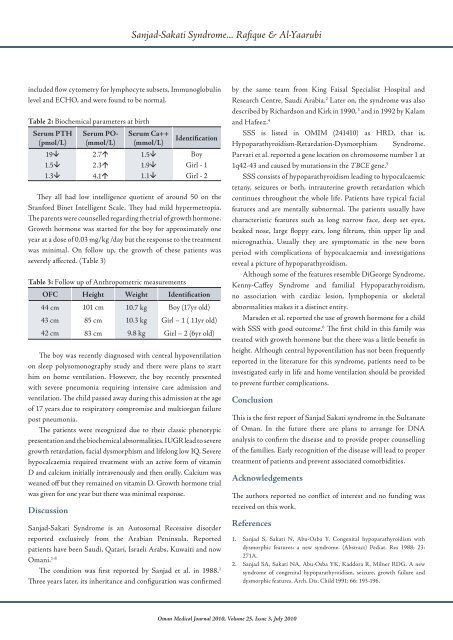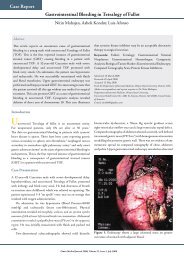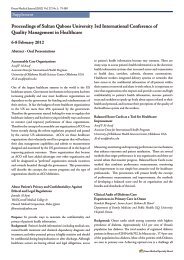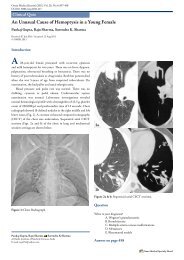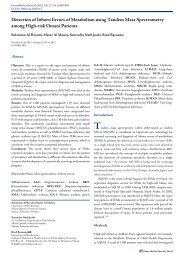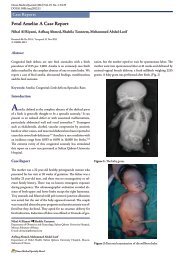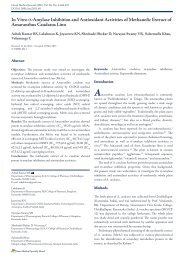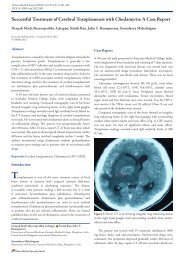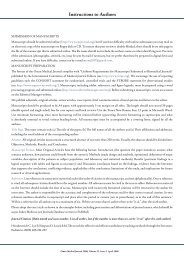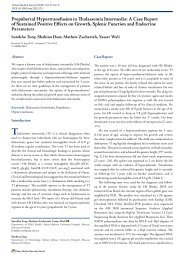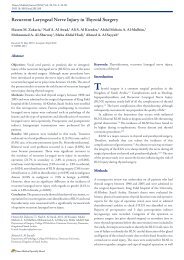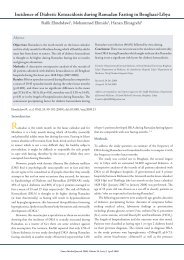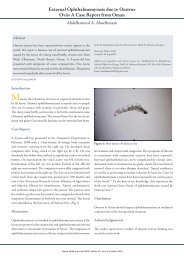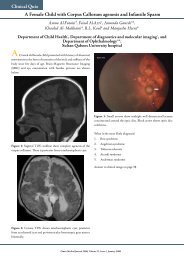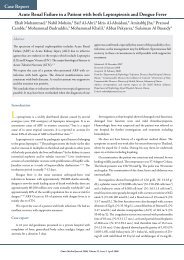Sanjad-Sakati Syndrome in Omani children - OMJ
Sanjad-Sakati Syndrome in Omani children - OMJ
Sanjad-Sakati Syndrome in Omani children - OMJ
Create successful ePaper yourself
Turn your PDF publications into a flip-book with our unique Google optimized e-Paper software.
<strong>Sanjad</strong>-<strong>Sakati</strong> <strong>Syndrome</strong>... Rafique & Al-Yaarubi<br />
<strong>in</strong>cluded flow cytometry for lymphocyte subsets, Immunoglobul<strong>in</strong><br />
level and ECHO, and were found to be normal.<br />
Table 2: Biochemical parameters at birth<br />
Serum PTH<br />
(pmol/L)<br />
Serum PO-<br />
(mmol/L)<br />
Serum Ca++<br />
(mmol/L)<br />
Identification<br />
19â 2.7á 1.5â Boy<br />
1.5â 2.3á 1.9â Girl - 1<br />
1.3â 4.1á 1.1â Girl - 2<br />
They all had low <strong>in</strong>telligence quotient of around 50 on the<br />
Stanford B<strong>in</strong>et Intelligent Scale. They had mild hypermetropia.<br />
The parents were counselled regard<strong>in</strong>g the trial of growth hormone.<br />
Growth hormone was started for the boy for approximately one<br />
year at a dose of 0.03 mg/kg /day but the response to the treatment<br />
was m<strong>in</strong>imal. On follow up, the growth of these patients was<br />
severely affected. (Table 3)<br />
Table 3: Follow up of Anthropometric measurements<br />
OFC Height Weight Identification<br />
44 cm 101 cm 10.7 kg Boy (17yr old)<br />
43 cm 85 cm 10.3 kg Girl – 1 ( 11yr old)<br />
42 cm 83 cm 9.8 kg Girl – 2 (6yr old)<br />
The boy was recently diagnosed with central hypoventilation<br />
on sleep polysomonography study and there were plans to start<br />
him on home ventilation. However, the boy recently presented<br />
with severe pneumonia requir<strong>in</strong>g <strong>in</strong>tensive care admission and<br />
ventilation. The child passed away dur<strong>in</strong>g this admission at the age<br />
of 17 years due to respiratory compromise and multiorgan failure<br />
post pneumonia.<br />
The patients were recognized due to their classic phenotypic<br />
presentation and the biochemical abnormalities. IUGR lead to severe<br />
growth retardation, facial dysmorphism and lifelong low IQ. Severe<br />
hypocalcaemia required treatment with an active form of vitam<strong>in</strong><br />
D and calcium <strong>in</strong>itially <strong>in</strong>travenously and then orally. Calcium was<br />
weaned off but they rema<strong>in</strong>ed on vitam<strong>in</strong> D. Growth hormone trial<br />
was given for one year but there was m<strong>in</strong>imal response.<br />
Discussion<br />
<strong>Sanjad</strong>-<strong>Sakati</strong> <strong>Syndrome</strong> is an Autosomal Recessive disorder<br />
reported exclusively from the Arabian Pen<strong>in</strong>sula. Reported<br />
patients have been Saudi, Qatari, Israeli Arabs, Kuwaiti and now<br />
<strong>Omani</strong>. 1-8<br />
The condition was first reported by <strong>Sanjad</strong> et al. <strong>in</strong> 1988. 1<br />
Three years later, its <strong>in</strong>heritance and configuration was confirmed<br />
by the same team from K<strong>in</strong>g Faisal Specialist Hospital and<br />
Research Centre, Saudi Arabia. 2 Later on, the syndrome was also<br />
described by Richardson and Kirk <strong>in</strong> 1990, 3 and <strong>in</strong> 1992 by Kalam<br />
and Hafeez. 4<br />
SSS is listed <strong>in</strong> OMIM (241410) as HRD, that is,<br />
Hypoparathyroidism-Retardation-Dysmorphism <strong>Syndrome</strong>.<br />
Parvari et al. reported a gene location on chromosome number 1 at<br />
1q42-43 and caused by mutations <strong>in</strong> the TBCE gene. 5<br />
SSS consists of hypoparathyroidism lead<strong>in</strong>g to hypocalcaemic<br />
tetany, seizures or both, <strong>in</strong>trauter<strong>in</strong>e growth retardation which<br />
cont<strong>in</strong>ues throughout the whole life. Patients have typical facial<br />
features and are mentally subnormal. The patients usually have<br />
characteristic features such as long narrow face, deep set eyes,<br />
beaked nose, large floppy ears, long filtrum, th<strong>in</strong> upper lip and<br />
micrognathia. Usually they are symptomatic <strong>in</strong> the new born<br />
period with complications of hypocalcaemia and <strong>in</strong>vestigations<br />
reveal a picture of hypoparathyroidism.<br />
Although some of the features resemble DiGeorge <strong>Syndrome</strong>,<br />
Kenny-Caffey <strong>Syndrome</strong> and familial Hypoparathyroidism,<br />
no association with cardiac lesion, lymphopenia or skeletal<br />
abnormalities makes it a dist<strong>in</strong>ct entity.<br />
Marsden et al. reported the use of growth hormone for a child<br />
with SSS with good outcome. 6 The first child <strong>in</strong> this family was<br />
treated with growth hormone but the there was a little benefit <strong>in</strong><br />
height. Although central hypoventilation has not been frequently<br />
reported <strong>in</strong> the literature for this syndrome, patients need to be<br />
<strong>in</strong>vestigated early <strong>in</strong> life and home ventilation should be provided<br />
to prevent further complications.<br />
Conclusion<br />
This is the first report of <strong>Sanjad</strong> <strong>Sakati</strong> syndrome <strong>in</strong> the Sultanate<br />
of Oman. In the future there are plans to arrange for DNA<br />
analysis to confirm the disease and to provide proper counsell<strong>in</strong>g<br />
of the families. Early recognition of the disease will lead to proper<br />
treatment of patients and prevent associated comorbidities.<br />
Acknowledgements<br />
The authors reported no conflict of <strong>in</strong>terest and no fund<strong>in</strong>g was<br />
received on this work.<br />
References<br />
1. <strong>Sanjad</strong> S, <strong>Sakati</strong> N, Abu-Osba Y. Congenital hypoparathyroidism with<br />
dysmorphic features: a new syndrome. (Abstract) Pediat. Res 1988; 23:<br />
271A.<br />
2. <strong>Sanjad</strong> SA, <strong>Sakati</strong> NA, Abu-Osba YK, Kaddora R, Milner RDG. A new<br />
syndrome of congenital hypoparathyroidism, seizure, growth failure and<br />
dysmorphic features. Arch. Dis. Child 1991; 66: 193-196.<br />
Oman Medical Journal 2010, Volume 25, Issue 3, July 2010


